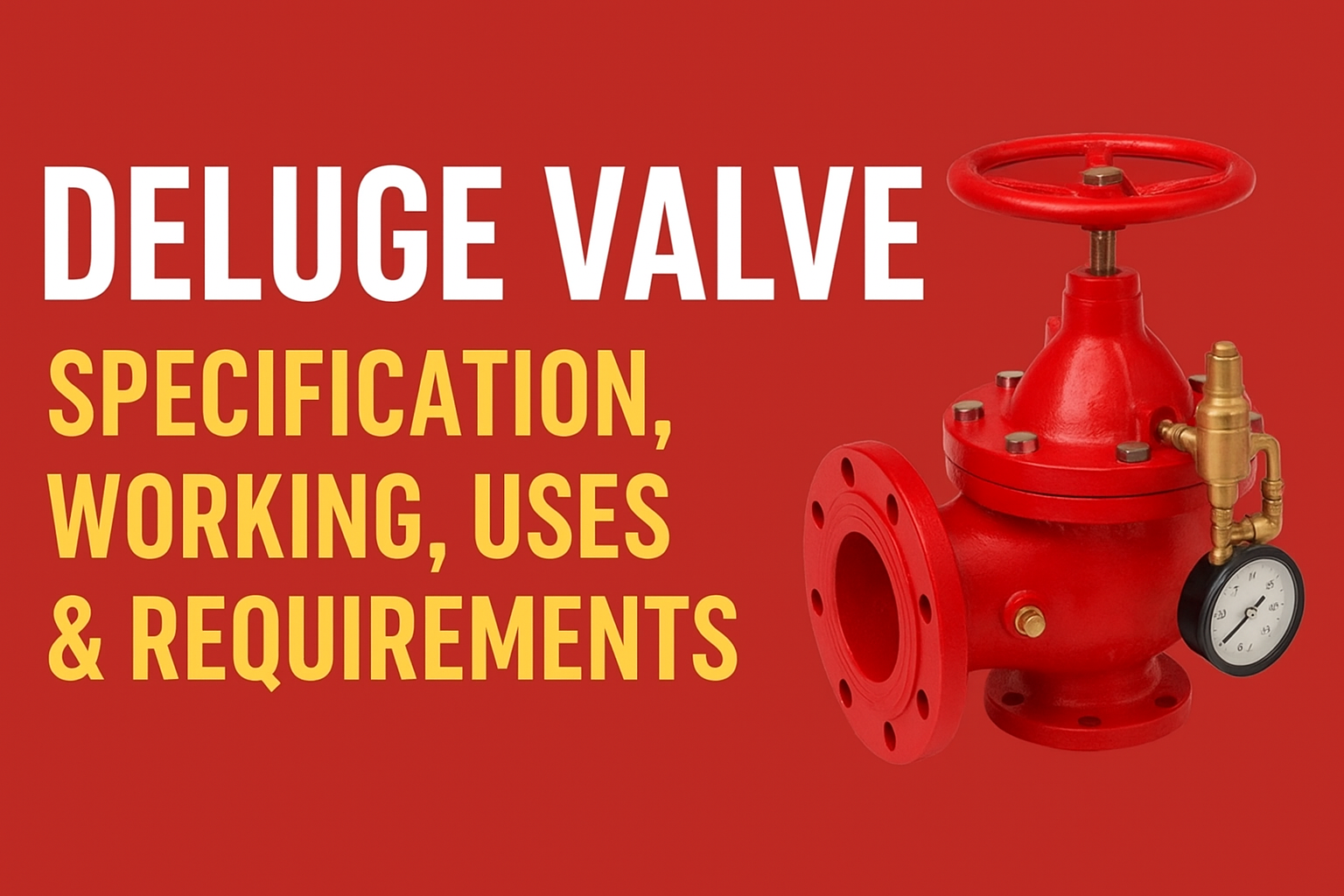Fire protection systems play a critical role in safeguarding industries, buildings, and equipment from fire hazards. One of the most essential components of an automatic fire protection system is the deluge valve.
In this article, we will understand what a deluge valve is, its specifications, working principle, applications, and installation requirements—all explained step-by-step in a simple and human-friendly way.
What is a deluge valve?
A deluge valve is a quick-opening water control valve used in deluge fire sprinkler systems.
Unlike a normal sprinkler system, where water is released only through individual sprinkler heads when heat activates them, a deluge system releases water through all open sprinklers or nozzles simultaneously once the valve is activated.
In simple words:
➡️ The deluge valve controls the water flow and, once triggered, floods the entire area with water for rapid fire suppression.
Step-by-Step Working of Deluge Valve
Let’s understand how a deluge valve works in a step-by-step process:
Step 1 – System Standby Condition
- The deluge valve remains closed under normal conditions.
- The piping network is dry and filled with air at atmospheric pressure.
- The water supply is ready but held back by the valve.
Read more.
- Fire Sprinkler Calculation in Hindi
- Types of Fire Sprinklers: Pendent, Upright, and Sidewall – Specifications and Working
- Fire Alarm Valve – Working, Types, Installation Guide & FAQs
Step 2 – Detection System Activation
- A fire detection system (heat, smoke, or flame detector) detects a fire.
- The detector sends a signal to the deluge valve release system.
Step 3 – Valve Opening
- The signal releases the pressure in the priming chamber above the diaphragm.
- Once the pressure is released, the main valve opens automatically.
Step 4 – Water Discharge
- Water flows rapidly through the valve into the piping network.
- All open nozzles/sprinklers discharge water over the protected area.
Step 5 – Fire Suppression
- The high flow rate and wide spray pattern quickly suppress or control the fire.
- Manual or automatic shutdown can be done after the fire is under control.
Technical Specifications of Deluge Valve
| Parameter | Description |
|---|---|
| Valve Type | Diaphragm- or piston-operated, Quick-opening type |
| Body Material | Cast Iron, Ductile Iron, Carbon Steel, or Bronze |
| Available Sizes | 2”, 2½”, 3”, 4”, 6”, 8” (Typical range) |
| Working Pressure | Up to 12 bar (175 psi) |
| End Connection | Flanged (ANSI / BS / DIN standards) |
| Trim Type | Wet trim, Dry trim, or Electrical trim |
| Operating Medium | Water or Foam solution |
| Finish | Red epoxy-coated or corrosion-resistant coating |
Types of Deluge Valve Trim
- Wet Pilot Trim – Uses water pressure as the control medium.
- Dry Pilot Trim – Uses air or nitrogen pressure for release control.
- Electrical Trim – Operated by electronic detection systems or control panels.
Each trim type is selected based on system design and environmental conditions.
Installation Requirements
Proper installation is key to reliable performance. Here are the basic requirements:
- Water Supply: Must be sufficient for the system’s designed flow rate.
- Pressure Gauges: Install on both inlet and outlet for monitoring.
- Main Drain Valve: For testing and maintenance.
- Manual Release Station: Should be near the valve for emergency activation.
- System Test Valve: To check functionality during inspection.
- Control Panel Connection: For electrical or automatic systems.
- Alarm Devices: Water motor gong or pressure switches for fire alarm signal.
Applications / Uses of Deluge Valve
Deluge valves are widely used in high-risk fire zones where fast fire spread is possible due to flammable liquids or gases. Common uses include:
- Oil & Gas Refineries
- Power Plants
- Aircraft Hangars
- Chemical & Petrochemical Plants
- Transformer Yards
- Storage Tanks and Loading Areas
- Industrial Processing Units
They are also used in foam-water systems, where foam concentrate mixes with water for better fire suppression in hydrocarbon areas.
✅ Advantages of Deluge Valve System
- Rapid and total water discharge over large areas
- Compatible with foam systems
- Quick response to fire detection signals
- Can be manually or automatically operated
- Reliable and easy to maintain
Maintenance and Testing
To ensure performance, regular testing and inspection are essential.
- Weekly: Visual inspection of valves and gauges
- Monthly: Trim function testing
- Quarterly: Alarm and release test
- Annually: Full flow test and cleaning of strainers
Proper maintenance ensures the system operates instantly during an emergency.
Conclusion
A deluge valve is a critical component of industrial fire protection systems. It ensures instant water discharge to control large fires in hazardous zones.
By understanding its working principle, specifications, and installation needs, you can ensure safety and compliance with fire protection standards like NFPA 15 and FM/UL guidelines.
